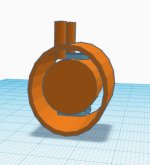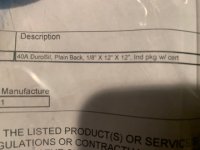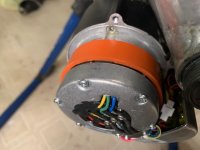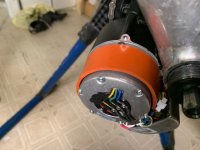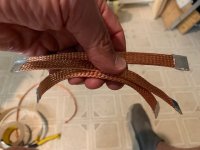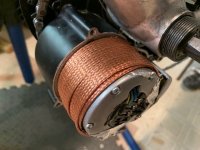JohnAnanda
10 mW
- Joined
- Mar 13, 2021
- Messages
- 32
Hi, I'd like to share my own experience with thermal dissipation.
I first did the mods with thermal pads and grease as indicated in the wiki.
I also added 20x30x2mm thermal pads against the motor laminations, between the flanges screws, and top of that, 3mm thermal pads wraped around the motor to make contact with the case.
I bought the thermal pads for cheap on Aliexpress, rated for 6 W/mK, but who knows what their real conductivity is..
It was better that before, obviously, but I still could reach 70°C (the min temp warning limit I've set) quickly when drawing 500+W continuously from the battery.
Then I decided to put as much aluminium as I could instead, like others have previously done.
I had 1.5mm and 2mm aluminium sheets laying around, so I first cut a 1.5mm shim to go under the motor (first described by a smart guy earlier in this thread), with thermal grease on both sides of the shim. I used a jigsaw and a file to make it, so it's not as pretty as a CNC machined one, but it was easy and did the job.
For the wraps around the motor, the use of an aluminium tube as described just earlier here would be the best, but I'm tight and lazy and wanted to use what I already had : that 2mm aluminium sheet.
So with the jigsaw I cut a 2cm wide band, and curved it around an empty spray can which happened to be approximately the same diameter as the motor. I cut it in 3cm long pieces and glued them with thermal compound against the motor laminations, between the screws.
Then I did the same with a larger band (can't remember the exact size, 3cm something). This width is already more difficult to work with when you don't have a proper roll bender machine, so I used two clamps around the empty spray can in order to bend it to the correct shape. Then I cut it into 3 pieces (I had to use a new band each time : only the center of the curve had the good radius and there are wastes..) and glued them around the motor, between the motor fixing screw hole.
It looks like this :
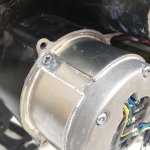
The advantage of this method is that even with the aluminium shims permanently attached to the motor, the mounting screws are still accessible and allow the motor to be easily removed and reinstalled for maintainance. Everything stays in place.
Yet, 2mm is not enough (3mm would be ideal) so I stuck 1mm thermal pads on theses curved shims, with thermal grease on top for good measure.
Now the good news : with this mod and the latest 20.1C3 firmware from Mbrusa (based on Mspider65 v13, which brings enhancements regarding heating and other things), I simply haven't managed to reach the low temp warning !
On my 'test hill' before (with thermal pads mod and 20.1C2), I would hit 70°C before the top when drawing 500 to 700W continuously. Now I'm just above 60°C at the top of the hill with full power all along.
Please not that I ride on the road with this bike, so with high power I go fast even uphill, so there's lots of airflow around the motor case, helping it cooling down. In a MTB situation with slower speed and high power uphill, it's probably possible to overheat the motor, but this would happen much later.
Also the temperature here theses days is 15-20°C. It will be different this summer with 30+°C, but I'm really happy with how this thing works now.
In conclusion :
Thick cheap thermal pads suck. Aluminium rocks.
Mspider65 and Mbrusa absolutely rock.
Edit : For the sake of completeness, I use a 48V motor with a 14S battery, with a 750W/16A limit (I was drawing probably 12 to 14A for the test reported above). I pedal at a maximum cadence around 80-85, with field weakening enabled.
I first did the mods with thermal pads and grease as indicated in the wiki.
I also added 20x30x2mm thermal pads against the motor laminations, between the flanges screws, and top of that, 3mm thermal pads wraped around the motor to make contact with the case.
I bought the thermal pads for cheap on Aliexpress, rated for 6 W/mK, but who knows what their real conductivity is..
It was better that before, obviously, but I still could reach 70°C (the min temp warning limit I've set) quickly when drawing 500+W continuously from the battery.
Then I decided to put as much aluminium as I could instead, like others have previously done.
I had 1.5mm and 2mm aluminium sheets laying around, so I first cut a 1.5mm shim to go under the motor (first described by a smart guy earlier in this thread), with thermal grease on both sides of the shim. I used a jigsaw and a file to make it, so it's not as pretty as a CNC machined one, but it was easy and did the job.
For the wraps around the motor, the use of an aluminium tube as described just earlier here would be the best, but I'm tight and lazy and wanted to use what I already had : that 2mm aluminium sheet.
So with the jigsaw I cut a 2cm wide band, and curved it around an empty spray can which happened to be approximately the same diameter as the motor. I cut it in 3cm long pieces and glued them with thermal compound against the motor laminations, between the screws.
Then I did the same with a larger band (can't remember the exact size, 3cm something). This width is already more difficult to work with when you don't have a proper roll bender machine, so I used two clamps around the empty spray can in order to bend it to the correct shape. Then I cut it into 3 pieces (I had to use a new band each time : only the center of the curve had the good radius and there are wastes..) and glued them around the motor, between the motor fixing screw hole.
It looks like this :

The advantage of this method is that even with the aluminium shims permanently attached to the motor, the mounting screws are still accessible and allow the motor to be easily removed and reinstalled for maintainance. Everything stays in place.
Yet, 2mm is not enough (3mm would be ideal) so I stuck 1mm thermal pads on theses curved shims, with thermal grease on top for good measure.
Now the good news : with this mod and the latest 20.1C3 firmware from Mbrusa (based on Mspider65 v13, which brings enhancements regarding heating and other things), I simply haven't managed to reach the low temp warning !
On my 'test hill' before (with thermal pads mod and 20.1C2), I would hit 70°C before the top when drawing 500 to 700W continuously. Now I'm just above 60°C at the top of the hill with full power all along.
Please not that I ride on the road with this bike, so with high power I go fast even uphill, so there's lots of airflow around the motor case, helping it cooling down. In a MTB situation with slower speed and high power uphill, it's probably possible to overheat the motor, but this would happen much later.
Also the temperature here theses days is 15-20°C. It will be different this summer with 30+°C, but I'm really happy with how this thing works now.
In conclusion :
Thick cheap thermal pads suck. Aluminium rocks.
Mspider65 and Mbrusa absolutely rock.
Edit : For the sake of completeness, I use a 48V motor with a 14S battery, with a 750W/16A limit (I was drawing probably 12 to 14A for the test reported above). I pedal at a maximum cadence around 80-85, with field weakening enabled.


